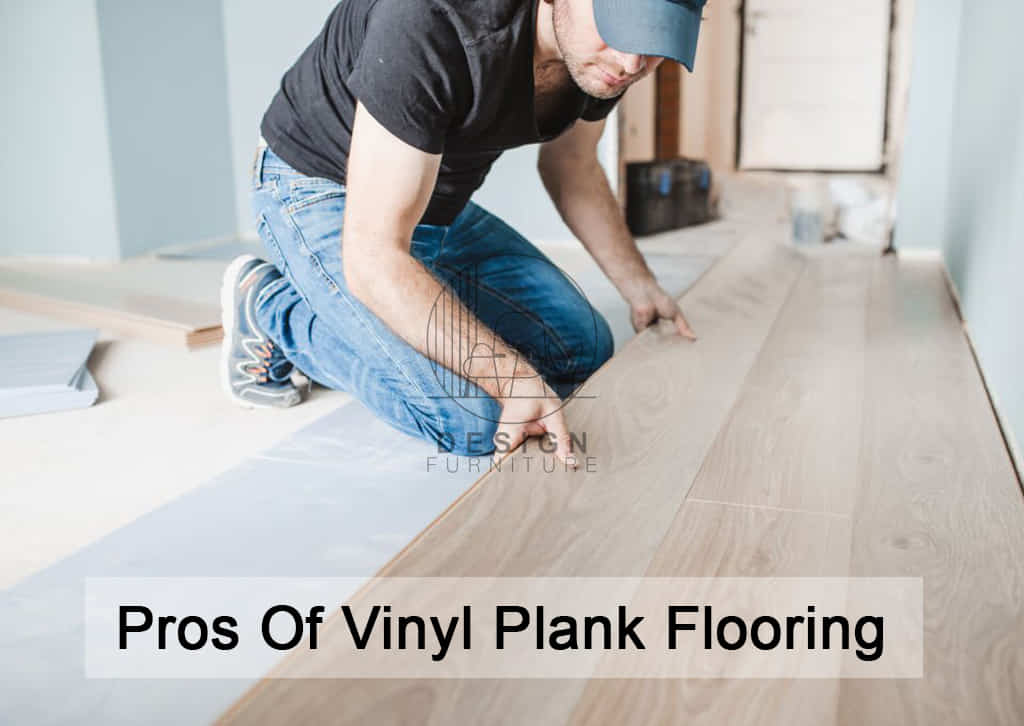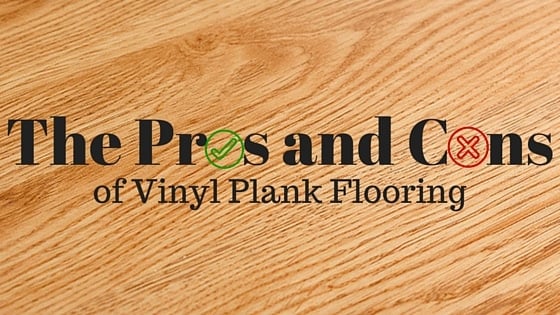The recent renovation of my living room had me grappling with a dilemma: what flooring to choose? Wood? Tile? Laminate? After endless browsing, I stumbled upon vinyl plank flooring, which seemed like a perfect middle ground offering the look of real wood with the practicality of vinyl. But was it too good to be true? To find out, I embarked on a journey of research, and let me tell you, it was quite the learning curve!

Image: designfurniture.ae
From its origins as a purely functional material to its rise as a stylish and affordable flooring option, vinyl plank has come a long way. The journey has been marked by advancements in technology and design, culminating in today’s incredibly realistic and durable product. But like any good investment, it pays to delve into the details before making a decision. Let’s explore the world of vinyl plank flooring together, weighing its benefits and limitations.
What is Vinyl Plank Flooring?
Vinyl plank flooring is a type of waterproof flooring made from polyvinyl chloride (PVC) and often combined with other materials like fillers and pigments. It comes in planks that resemble real wood, offering a realistic aesthetic, but with added durability and water resistance. Think of it as a “best of both worlds” solution for those who love the look of wood but need a flooring that’s also practical for everyday life.
Unlike traditional vinyl tiles of the past, vinyl planks are wider and longer, mimicking the natural appearance of real wood. These planks are often designed with realistic wood grains, knots, and color variations, adding a touch of natural elegance to any space. The planks typically click together, creating a seamless and durable floor.
Pros of Vinyl Plank Flooring
Let’s get to the heart of the matter: why are people choosing vinyl plank flooring over traditional options like hardwood or tile?
Durability and Resistance
The first pro that leaps out is its **durability**. Vinyl plank flooring is remarkably resilient against scratches, dents, and fading. This is especially important for high-traffic areas like living rooms, kitchens, and hallways. It stands up well to foot traffic, furniture, and even the occasional dropped item. It’s a lifesaver for those with pets and active families!
But the benefits don’t stop at resisting damage. Vinyl plank flooring is also highly **resistant to water**. This makes it a perfect choice for kitchens, bathrooms, and even basements, as it can withstand spills, moisture, and humidity without warping or swelling.

Image: www.bestlaminate.com
Affordability and Value
If you’re looking for a flooring option that doesn’t break the bank, vinyl plank might be the one. It is often **more affordable** than hardwood, tile, or even laminate flooring. This can be a significant cost-saving factor, especially when considering a large area.
Another point to consider is its **long lifespan**. While vinyl planks are cheaper upfront, they tend to last longer than cheaper alternatives like laminate flooring. Overall, you get a good value for your money with vinyl plank, offering both affordability and longevity.
Style and Variety
Vinyl plank flooring isn’t just about practicality — it’s also about aesthetics. With advancements in technology, manufacturers have crafted remarkably realistic designs, mimicking the appearance of real wood. There are numerous textures, colors, and styles to choose from, allowing you to match your desired aesthetic. Some vinyl planks even have a **realistic wood-grain texture** that adds an extra level of authenticity.
Beyond the traditional “wood look,” vinyl plank flooring is available in various styles like **stone**, **tile**, and **concrete**. This allows you to create a wide range of looks, meeting your individual preferences. If you want the look of reclaimed wood, porcelain tile, or even a sleek, modern concrete finish, vinyl plank has you covered.
Easy Installation and Maintenance
Here’s another big win for vinyl plank flooring: it’s **easy to install**. Whether you’re a seasoned DIYer or a weekend warrior, you can typically install vinyl plank yourself, saving on labor costs. Most vinyl planks come with a click-and-lock system that simplifies the installation process.
And once it’s down, **maintenance is relatively easy**. Vinyl plank flooring is resistant to stains and dirt, making it easier to keep clean. A regular sweep and occasional mopping are typically all you need to keep your floor looking its best.
Cons of Vinyl Plank Flooring
Now that we’ve explored the sunny side of vinyl plank flooring, it’s time to shed light on the potential drawbacks. Like any flooring option, vinyl plank has its own set of pros and cons, and it’s important to weigh them carefully before making a final decision.
Environmental Concerns
One of the most significant downsides is that vinyl plank flooring is made from PVC, which is a **non-renewable resource** and can release harmful chemicals during production and disposal. While the industry is moving towards more sustainable practices, this remains a concern for environmentally conscious homeowners.
Another environmental consideration is the **footprint of shipping** these products. With many vinyl planks being manufactured overseas, the carbon footprint of transporting them can be substantial. Some manufacturers are attempting to address this by establishing domestic production lines, but it remains a factor to consider.
Potential for Scratches and Dents
While vinyl plank is known for its durability, it is still **susceptible to scratches and dents**. While it withstands wear and tear remarkably well, deep scratches or gouges can occur with heavy objects or sharp items. However, it’s worth noting that many manufacturers offer a protective layer that helps minimize wear and tear.
Not a Suitable Option for Extreme Temperatures
Vinyl plank flooring is generally stable across a wide range of temperatures. However, it can become **brittle in extreme cold**, making it less suitable for unheated garages, basements, or areas exposed to direct sunlight. If you’re planning to install vinyl plank flooring in an area with wide temperature variations, it’s crucial to check with the manufacturer’s recommended guidelines.
Limited Customization
Vinyl plank flooring offers a wide array of styles, but it still **lacks the customization options** of real wood floors. For example, you can’t refinish vinyl plank flooring, and sanding down scratches isn’t an option. If you’re envisioning a unique or personalized floor design, vinyl plank may not be the ideal material.
Finally, while the click-and-lock system is user-friendly, it can sometimes **lead to slight gaps** between planks. These gaps are often barely noticeable, but they can become more prominent in areas with high foot traffic or over time. This can potentially dampen the overall aesthetic of the flooring, especially if you prefer a completely seamless look.
Tips and Expert Advice for Vinyl Plank Flooring
Before you dive headfirst into a vinyl plank flooring project, here are some tips from an expert (me!), based on my research and experience.
Choose the right type: There are several types of vinyl plank flooring, including solid vinyl, luxury vinyl tile (LVT), and WPC (wood plastic composite). Research and understand the differences to decide which type best suits your needs and budget.
Consider the underlayment: An underlayment can enhance the comfort, sound insulation, and durability of your vinyl plank flooring. A good underlayment can also help to cushion the floor and minimize noise from footsteps.
Proper installation is key: This may seem obvious, but ensuring correct installation is crucial for the longevity of your vinyl plank floors. A professional installation can save headaches and potential problems down the line.
Don’t underestimate the importance of maintenance: While vinyl plank is easy to clean, consistent maintenance is essential to keep it looking its best. Regular sweeping, spot cleaning, and a periodic deep clean are crucial for protecting your investment.
FAQ on Vinyl Plank Flooring
Let’s address some common questions about vinyl plank flooring.
Q: Is vinyl plank flooring waterproof?
A: While vinyl plank is highly water-resistant, it’s not completely waterproof. It can handle spills and even standing water for a short time, but prolonged exposure can damage the floor.
Q: Can vinyl plank flooring be installed over existing flooring?
A: In most cases, yes, you can install vinyl plank flooring over existing flooring, but it’s essential to check the manufacturer’s guidelines and ensure the existing floor is level and smooth.
Q: How long does vinyl plank flooring last?
A: With good maintenance and careful installation, vinyl plank flooring can last anywhere from 15 to 25 years or even longer.
Q: What is the best way to clean vinyl plank flooring?
A: A gentle sweep or vacuuming is usually enough for everyday maintenance. For deeper cleaning, use a damp mop with a mild cleaner, avoiding harsh chemicals or abrasive scrubbers.
Pros And Cons Of Vinyl Plank Flooring
Q: Can vinyl plank flooring be refinished?
A: No, you can’t refinish vinyl plank flooring. Once it’s damaged, it’s usually best to replace the affected plank.
In conclusion, vinyl plank flooring presents a compelling combination of style, durability, and affordability. It is a fantastic choice for many homeowners seeking a low-maintenance and visually appealing flooring option, especially in high-traffic areas or rooms prone to spills and moisture. However, it’s crucial to weigh its potential drawbacks, particularly its environmental impact and limited customization options, before making a final decision.
So, are you considering vinyl plank flooring for your next home improvement project? Let us know in the comments below!





